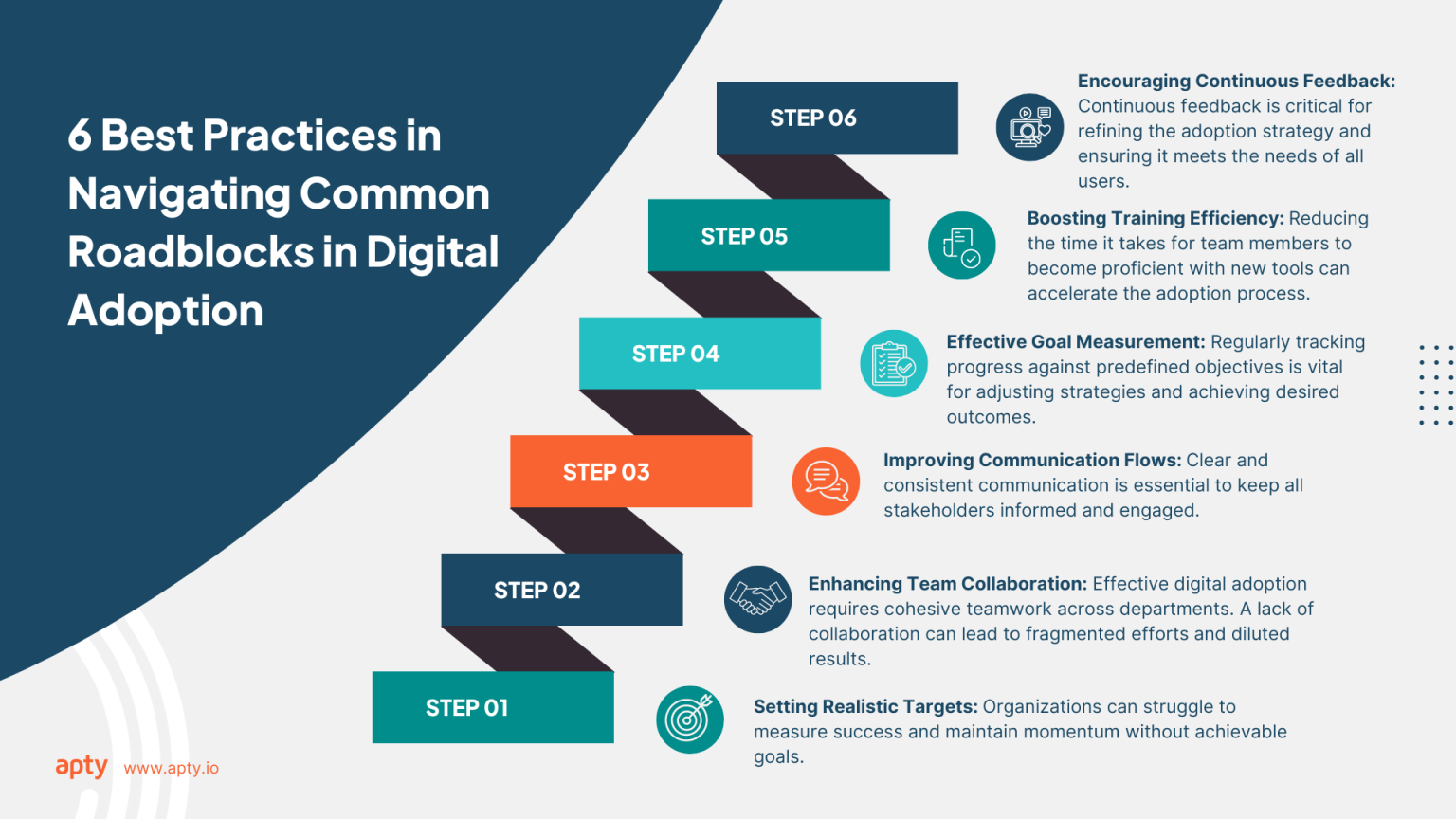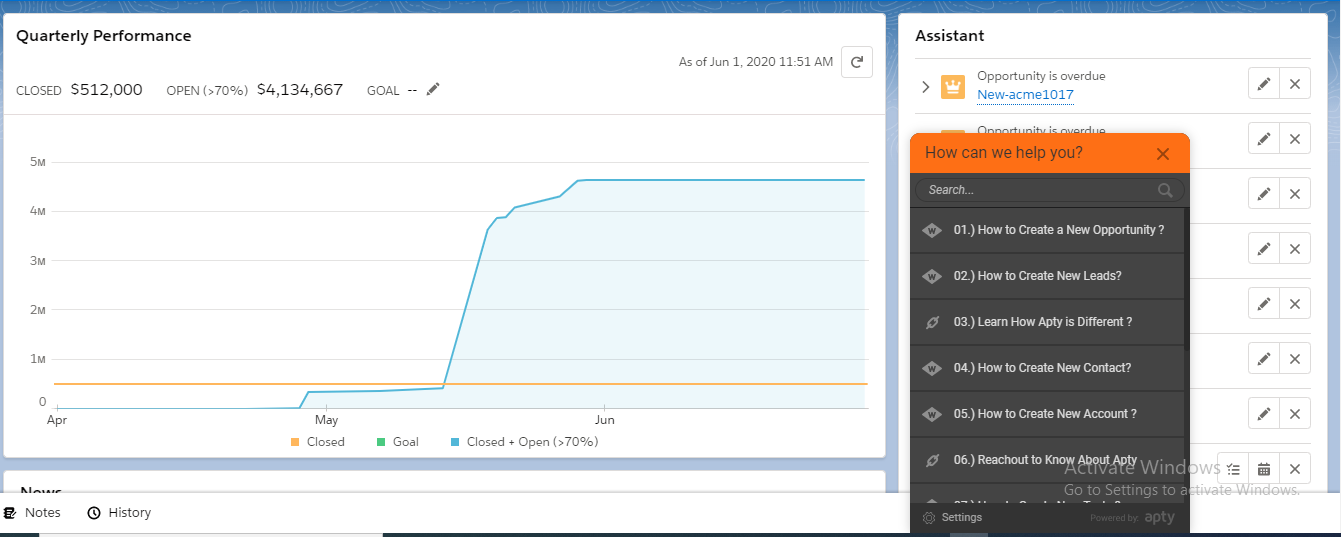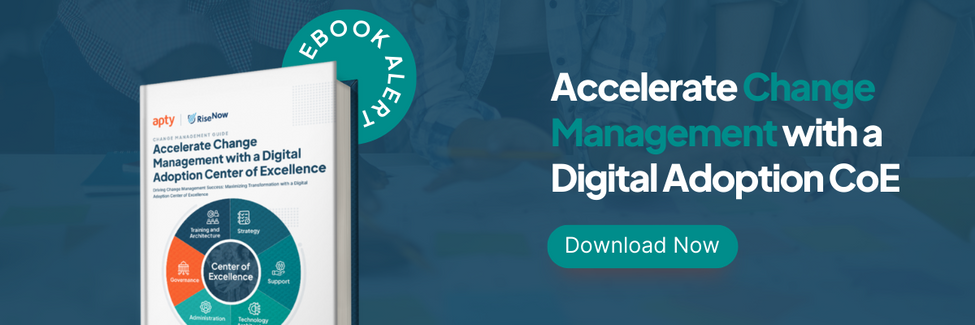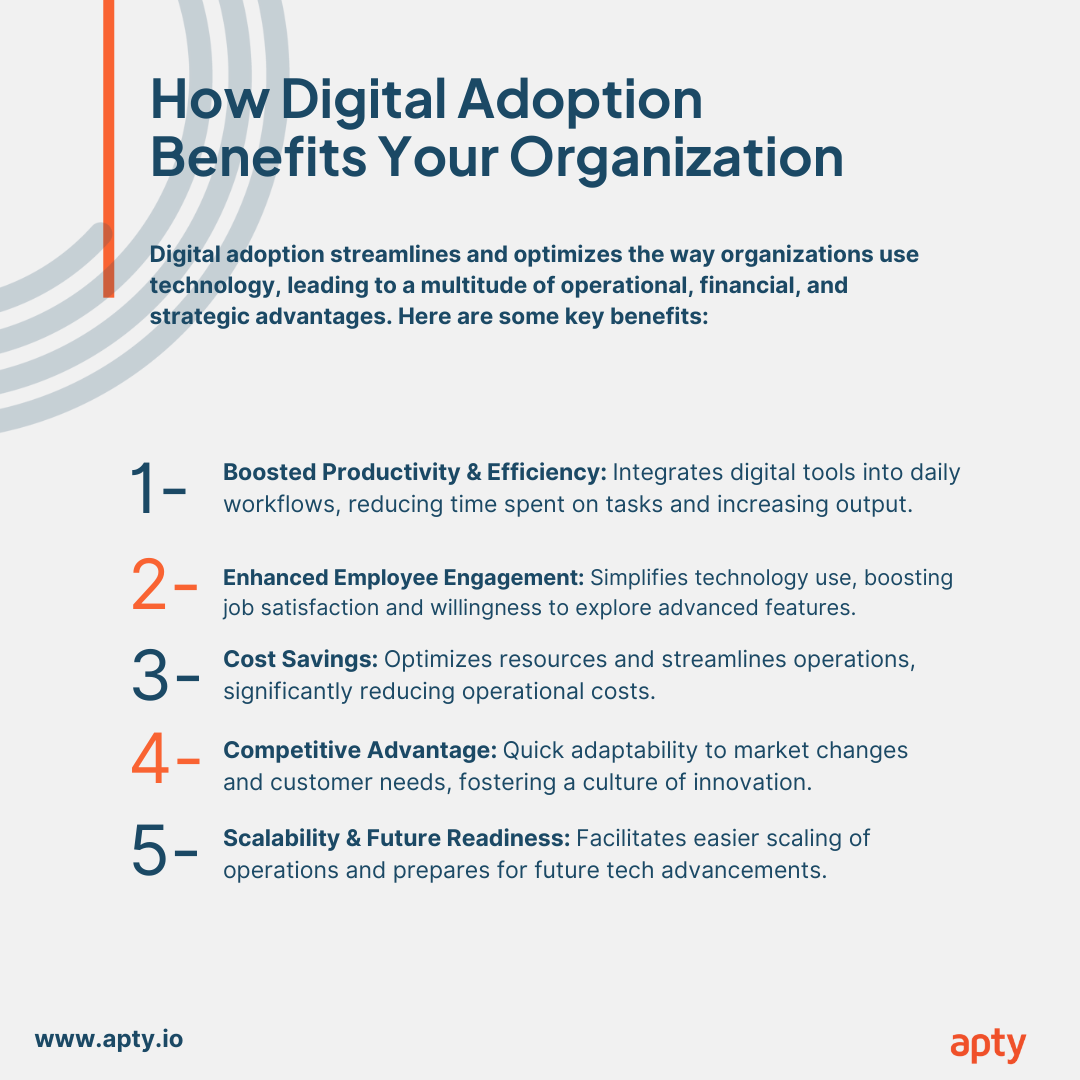The 9 Pillars of Creating an Outstanding Digital Adoption Strategy
At a time when technology shapes every aspect of business operations, the impact of your digital adoption strategy is crucial. Finance, strategy, operations, and technology leaders face challenges beyond selecting cutting-edge tools; they must ensure comprehensive integration and usage of those tools throughout their organizations.
Despite digital technology’s critical role, a staggering 73% of businesses fail to generate value from their digital transformation initiatives. Further compounding this issue, 70% of change programs fail due to employee resistance, highlighting a significant gap in adoption strategies.
Yet, the investment in digital transformation continues to grow exponentially. According to IDC, spending on digital technology by organizations is expected to grow at 2X rate of the economy in 2024, driven by the need to develop digital business models and enhance digital capabilities. The global digital investment market is projected to grow by 6.19% from 2024 to 2027, reaching a market volume of $3,342 billion in 2027.
This significant investment underscores organizations’ clear recognition of the value of digital transformation. Yet, a consistent failure to utilize this value points to a common issue: an ineffective digital adoption strategy.
Often, leaders do not fully integrate digital adoption within their broader transformation initiatives, mistakenly treating it as a separate entity, which leads to failures in their digital transformation efforts.
The following sections outline the foundational pillars for a stellar digital adoption strategy. These principles are crafted to assist leadership in tackling the complexities of new software adoption—from initial planning and user training to ongoing support and performance analytics. Adopting these pillars can significantly improve software utilization rates and achieve the desired operational outcomes.
Whether your goal is to streamline operational processes with systems like Oracle, SAP, or ServiceNow, boost customer engagement through platforms like Salesforce, or optimize human resources management with solutions like Workday, the strategies discussed here apply across the board and have been proven in countless business settings. We will provide practical examples, actionable insights, and strategic advice to strengthen your digital adoption efforts.
Ready to redefine your approach to digital adoption? Let’s delve into the strategic elements that can boost your organization’s technological capabilities and strategic advantage.
But before jumping to that, we must know:-
What is a Digital Adoption Strategy?
A Digital Adoption strategy is a systematic plan to seamlessly integrate new applications into daily business operations. The aim is to optimize processes, eliminate obstacles, and establish a framework that aligns with the organization’s objectives.
Organizations often begin by refining their existing processes. This step is crucial as it ensures that the new technology will be integrated into an already streamlined and efficient environment.

However, simply optimizing processes isn’t enough. A common digital adoption challenge many organizations encounter is rushing into planning without first addressing potential roadblocks. These barriers, if overlooked, can severely disrupt the implementation phase.
The obstruction in the adoption process could arise because of the following factors:-
- Resistance to Change in Digital Adoption
- Insufficient Employee Training and Onboarding for Technology Adoption
- Complex and Unintuitive Digital Technology
- Inability to Measure and Monitor User Adoption
- Fragmented User Experiences Across Multiple Applications
- Lack of a Clear Digital Adoption Strategy
- Challenges in Knowledge Retention
These roadblocks have to be addressed while creating the strategy.
Why Does Digital Adoption Matter?
According to Gartner, worldwide IT spending is projected to total $5.06 trillion in 2024, an 8% increase from 2023. This surge, up from the previous quarter’s forecast of 6.8%, underscores a robust trajectory that suggests IT expenditures could surpass $8 trillion before the decade’s close.
Meanwhile, Digital Transformation (DX) spending is projected to reach $2.15 trillion. By 2027, global digital transformation spending will escalate to $3.9 trillion. This steep rise highlights the accelerating pace at which organizations invest in technology to reshape their business processes, enhance efficiency, and foster innovation.

These statistics reflect a shift towards a digital-first approach in business strategies. The significant increase in spending demonstrates a clear recognition of digital technology’s critical role in maintaining competitive advantage and ensuring long-term success.
The risks for organizations refraining from investing in digital adoption are stark. Falling behind in this accelerating investment race can mean stalling your organization’s growth and losing competitive ground to those who effectively leverage their digital strategies to realize tangible benefits. In an environment where IT and digital transformation spending is skyrocketing, maintaining competitiveness necessitates a proactive approach to digital adoption.
Digital adoption is not merely about acquiring technology but effectively integrating it into all facets of your business operations. It’s a critical component of digital transformation, ensuring that technological investments deliver their promised benefits and drive real value.
Proper digital adoption empowers organizations to:
- Maximize ROI on Software Investments: Ensuring that each dollar spent on technology returns and multiplies in value, contributing positively to the business objectives.
- Enhance Operational Efficiency: Streamlining processes and reducing redundancies through effective technology use, thus responding more quickly to market changes and customer needs.
- Improve Employee Engagement & Productivity: By reducing the learning curve associated with new technologies and fostering a tech-savvy workforce. A recent study by Hubspot highlighted that low productivity costs employers around USD $1.8 billion annually.

Relevant read: Digital Adoption – What it is & Why it is Important
Simplifying Digital Adoption
While the concept of digital adoption might seem daunting, it can be straightforward when planned strategically alongside digital transformation efforts. The keys to success include:
- Analyzing Problems: Understanding the specific challenges and obstacles that your technology is meant to solve.
- Encouraging User Adoption: Motivating employees to embrace change by highlighting new technologies’ personal and professional benefits.
- Providing Relevant Training: Tailoring training sessions to meet the specific needs of your workforce, ensuring they are equipped to use the new systems effectively.
- Understanding User Needs: Gathering continuous feedback to refine the approach and support provided, thus ensuring the adoption strategy meets all user requirements.
By addressing these areas, organizations can not only navigate but also capitalize on the challenges of digital adoption, ensuring smoother transitions to new technologies and a higher success rate in their digital transformation efforts.
Keeping all these in mind, we have listed 9 important digital adoption strategies that would act as a checklist for your organization.
- Crafting a Unified Vision for Digital Leadership
- Aligning Roles for Effective Digital Transformation
- Implementing Strong Data Governance in Digital Adoption
- Optimizing Training for Effective Digital Adoption
- Enhancing Interdepartmental Communication for Digital Success
- Adapting Digital Strategies in Real-Time
- Crafting a Flexible Content Strategy for Diverse Learners
- Optimizing User Support and Leveraging Feedback for Success
- Driving Continuous Improvement in Digital Adoption
9 Pillars That Make An Amazing Digital Adoption Strategy
Planning Phase
1. Proper vision from leadership
“A vision without a strategy remains an illusion”
– Lee Bolman
C-suite executives must share a cohesive vision that aligns with the organization’s objectives, clearly detailing digital initiatives’ path and expected outcomes.
Misalignments in vision across different departments often lead to inefficiencies and setbacks. Establishing a clear, unified end goal through consensus among top executives saves time and prevents conflicts.
Is your organization’s vision aligned with its digital transformation goals?
2. Aligning Roles for Effective Digital Transformation
Defining clear roles and responsibilities within the organization is crucial to avoid confusion as digital transformation progresses.
Contrary to the common misconception, successful digital transformation is not the sole responsibility of the CIO; 71% of executives believe employee engagement is crucial to business success.

This indicates that digital adoption is a collective effort requiring engagement from all C-suite executives and active participation from mid-level managers. Like in team sports, successful digital adoption demands coordinated effort and shared responsibilities.
How well are roles defined in your digital strategy?
3. Implementing Strong Data Governance in Digital Adoption
Effective data governance begins as users interact with new systems, where they often encounter “feature hell,” leading to potential system misuse. To prevent this, implementing a Digital Adoption Platform (DAP) can be crucial.

A DAP helps enforce data integrity by making crucial fields mandatory, eliminating duplicate data, and guiding users to input data in the correct format. This ensures accurate data collection and minimizes human error.
Is your data governance strong enough to support your digital initiatives?
Execution Phase
4. Optimizing Training for Effective Digital Adoption
Implement inclusive and personalized training programs and balance technology deployment with robust user adoption strategies by tailoring training to meet the diverse needs of different teams.

Example types of training formats:
- LXP courses
- LMS courses
- Live online training
- PPT
- Videos
- Knowledgebase
- Walkthroughs and Workflows (On-screen guidance)
This variety caters to different learning styles and significantly enhances the learning experience, reducing the time to adoption and increasing ROI.
Effective training is not just about delivery but about understanding and meeting the unique needs of each user” highlights the necessity of personalized learning paths in digital adoption.
All these formats empower a user and open a door for learning opportunities.
However, a digital adoption platform makes all of this much easier. A digital adoption platform allows you to create walkthroughs and tooltips that guide users inside the application. It reduces the load on the L&D department and propels the learning curve of any user.
5. Enhancing Interdepartmental Communication for Digital Success
Collaboration across departments is crucial for digital adoption success. The Learning and Development (L&D) team needs to work closely with HR, team leads, managers, and project owners. This collaboration ensures the creation of relevant and timely training content that meets everyone’s needs.
Using digital adoption platforms like Apty can guide users step-by-step through new applications, significantly boosting efficiency and productivity. But how well does your organization facilitate cross-departmental collaboration?

Maintaining a continuous flow of information is vital. Regular updates keep all stakeholders engaged and informed. Leveraging digital adoption tools helps provide insights into how applications are used and identifies gaps in business processes.
This ongoing communication ensures that everyone understands digital adoption initiatives’ goals, processes, and benefits, creating a more cohesive and informed organization.
6. Adapting Digital Adoption Strategies in Real-Time
Implementing digital adoption strategies requires flexibility, allowing you to make adjustments based on real-time feedback and your business’s unique demands. Being responsive to user needs and current technological trends is crucial. This responsiveness helps accommodate the learning curve associated with new technologies and systems.
Is your digital adoption strategy flexible enough to respond to user feedback effectively? By staying adaptive, you ensure that your digital tools and processes remain relevant and efficient, meeting the evolving needs of your users and keeping pace with technological advancements.
Implementation Phase
The implementation phase is the critical stage at which your digital adoption strategy comes to life. Here, you equip users with the resources and support needed to confidently utilize the new technology and maximize its potential. This phase focuses on three key pillars:
7. Crafting a Flexible Content Strategy for Diverse Learners
Address your workforce’s varied learning preferences by offering training and informational content in multiple formats, including interactive and on-demand options. This approach ensures that all users can find materials that help them best understand and utilize new technologies effectively.

Leveraging a digital adoption platform, create dynamic content such as tooltips and walkthroughs that guide users inside the application, enhancing their ability to learn in the flow of work. Diverse content delivery can bridge the gap between confusion and clarity, facilitating smoother transitions to new technologies.
How does your organization tailor content for diverse learning styles?
8. Optimizing User Support and Leveraging Feedback for Success
Focusing on reducing support tickets is a key indicator of successful user training and system usability. By analyzing the types and frequencies of reported issues, you can adjust your training and support efforts, boosting user confidence and reducing their dependence on the help desk.
Collecting and utilizing user feedback is essential for refining the adoption process. This feedback helps identify areas for improvement and ensures that your digital adoption strategies align with user needs and business goals. By continuously gathering and acting on user insights, you can make sure your digital tools and processes remain effective and user-friendly.
9. Driving Continuous Improvement in Digital Adoption
Analyze and Adapt. Commit to continuous evaluation and improvement based on detailed analytics from user interactions and business process assessments. Regular analysis helps pinpoint successes and areas for enhancement, driving better decision-making for future initiatives.
The businesses are constantly under transformation to make it effective and relevant these organizations should always analyze the gap in technology, user onboarding, user experience, and business processes.
Then they should also measure the impact of these analyses or draw insights to tweak the adopted practice and methods.
It will help them to improve and prepare for the next transformation wave. Most of it can be achieved by using applications like Apty which help you to get two types of analytics and these analytics are:-
- Application analytics:- Helps to understand how users are using the deployed application and identify gaps.
- Walkthrough analytics:- Helps admins to recognize where the users are struggling with the Walkthroughs (workflows) and help them to improve the flows.
Read More on this:- Digital adoption done in the right way

In this phase, you should not rush the process as missing key aspects could have an adverse effect on your initiative. Hence, take time and then expand it to the larger group and always be on analyzing mode to avert any possible mishap.
For this, you can use tools like DAP that will help you analyze how the user is behaving while adopting an application. This kind of tool will help you understand where the gap is and how to overcome those gaps, further, you will get a recommendation from the tool itself but such a feature is only available with Modern DAP.
Deep dive:- Intelligent and Modern Digital Adoption Platform
Role of Digital Adoption in Digital Transformation
Digital transformation involves leveraging new technologies to improve customer experiences, internal processes, and service offerings. Examples include modernizing legacy applications through new cloud software, launching online self-service customer portals, or implementing advanced enterprise systems like CRMs or ERPs.
While these technologies can significantly innovate and enhance a company’s offerings, their success hinges on effective implementation and user engagement. This is where a robust digital adoption strategy becomes crucial.
Key Aspects of Digital Adoption in Digital Transformation
- Enabling Comprehensive Integration: Digital adoption seamlessly integrates new technologies within existing workflows, enhancing productivity, customer interactions, and operational efficiency. It bridges the gap between technology’s potential and its practical use.
- Empowering Users: Successful digital transformation relies on end-users’ ability to effectively utilize new technologies. Digital adoption provides continuous, contextual training and on-demand support, overcoming resistance and fostering a technology-positive culture.
- Measure Impact and Drive Continuous Improvement: Continuous monitoring and evaluation assess the impact of new technologies on business operations and user performance. This feedback informs adjustments and improvements, ensuring digital transformation initiatives are successful and sustainable.
- Aligning Technology with Business Strategy: Digital adoption aligns technological changes with strategic business goals, justifying technology investments and ensuring they deliver tangible business outcomes like increased revenue, reduced costs, and competitive advantages.
- Facilitating Scalability and Innovation: Promoting widespread acceptance and understanding of new technologies, digital adoption enables effective scalability and fosters ongoing innovation, allowing organizations to maintain a competitive edge and adapt to market changes.
Digital adoption is indispensable when it enhances operational efficiencies and user satisfaction, ensuring transformation efforts are sustainable and closely aligned with broader business objectives.
Through digital adoption, organizations can empower their end-users to embrace new digital processes and tools, thereby maximizing the potential of technological investments and driving meaningful organizational change.

Digital Adoption Benefits Your Organization

Key To Successful Digital Adoption – Apty, a Digital Adoption Platform
Organizations face immense challenges with their digital transformation initiatives, especially with it comes to the adoption of new technologies. To address these challenges, roles such as Chief Transformation Officers (CTOs) have emerged, going beyond traditional CIO responsibilities to ensure technology transformations align with organizational goals. These leaders emphasize the importance of a well-defined digital adoption plan, recognizing that the success of digital transformation hinges on the effective adoption of new applications and software.
Digital Adoption Platforms (DAPs) like Apty have become essential in this context. DAPs facilitate user onboarding and adoption by offering on-screen guidance over web-based applications. As software applications frequently update and the number of tools a user must navigate grows, training each individual on each update becomes impractical. Here, DAPs play a critical role by reducing dependency on constant retraining and streamlining the onboarding process.
To illustrate the impact of Apty, here are some real-time digital adoption use cases across multiple industries, showcasing how Apty has streamlined processes and enhanced efficiency:
| Company | Industry | Digital Adoption Use Case | Brief Description |
| Mattel | Manufacturing & Entertainment | Streamline HR systems & onboarding. Enhance processes & support |
Implemented Workday HCM with Apty, achieving 90% platform utilization in 60 days, reducing support tickets, and enhancing user competency across multiple languages. |
| ChenMed | Healthcare | Streamline employee onboarding, engagement, and organizational goals |
Streamlined employee onboarding and engagement across 80 healthcare centers with Apty, enhancing understanding, reducing support tickets, and improving compliance and efficiency. |
| MaryKay | Cosmetic Retail | Streamline onboarding and training across the organization |
Utilized Apty on Salesforce to streamline training for over 3 million consultants worldwide, significantly reducing support tickets and boosting sales by enhancing customer experiences. |
| US Airline | Aviation | Enabling employees to use Clarity PPM effectively |
Adopted Apty for Clarity PPM, cutting project time by over 50%, eliminating user guides, ensuring compliance, and boosting productivity and satisfaction. |
| Leading Bank | Banking and Financial Services |
Accelerating Digital Adoption and Streamlining Operational Processes. |
Faced with integration challenges during M&As, The Bank implemented Apty to streamline software onboarding, enforce compliance, and save $1 million, enhancing user adoption and operational efficiency. |
| Global Bank | Banking and Financial Services |
Training and On-boarding of Clarity PMM software |
Overcame Clarity PPM adoption challenges with Apty, providing guidance and analytics that cut support costs by 80% and saved $275k on training, enhancing efficiency and adoption. |
Apty is the leader in the DAP space with our data-centric approach. Unlike other platforms, Apty analyzes how applications are used within the organization. It identifies bottlenecks and challenges faced by users in real time. Based on this analysis, Apty creates targeted walkthroughs and guides that address specific user issues, ensuring that the software is used fully and the business processes are followed accurately.
The benefits of implementing a DAP like Apty are substantial. Apty saves time and money by boosting employee productivity, delivering a clear ROI. Its comprehensive real-time analytics and reporting capabilities provide unparalleled visibility into how digital tools are used across your organization. This transparency allows you to monitor user engagement, track progress, and identify areas where additional support or training might be needed. Understanding and responding to user behavior through detailed insights helps you make informed decisions, quickly address issues, and ensure that your digital transformation efforts stay on track. By improving efficiency and visibility, Apty ensures that digital adoption drives genuine value and supports your broader digital transformation goals.
Choosing the right Digital Adoption Platform is crucial for any organization committed to successful digital transformation. With its unique, analytics-driven approach, Apty provides a compelling solution that aligns with businesses’ strategic needs. It not only maximizes the potential of new technologies but also delivers long-term benefits and a significant return on investment by enhancing operational efficiency and providing detailed insights into user engagement.
Apty’s ability to deliver real-time analytics and targeted support ensures that digital adoption efforts are not only successful but also sustainable, providing long-term benefits and a significant return on investment.
Table of Contents
- The 9 Pillars of Creating an Outstanding Digital Adoption Strategy
- What is a Digital Adoption Strategy?
- Why Does Digital Adoption Matter?
- Best Practices in Navigating Common Roadblocks in Digital Adoption
- Simplifying Digital Adoption
- 9 Pillars That Make An Amazing Digital Adoption Strategy
- Planning Phase
- 2. Aligning Roles for Effective Digital Transformation
- 3. Implementing Strong Data Governance in Digital Adoption
- Execution Phase
- 4. Optimizing Training for Effective Digital Adoption
- 5. Enhancing Interdepartmental Communication for Digital Success
- 6. Adapting Digital Adoption Strategies in Real-Time
- Implementation Phase
- 7. Crafting a Flexible Content Strategy for Diverse Learners
- 8. Optimizing User Support and Leveraging Feedback for Success
- 9. Driving Continuous Improvement in Digital Adoption
- Role of Digital Adoption in Digital Transformation
- Key Aspects of Digital Adoption in Digital Transformation
- Digital Adoption Benefits Your Organization
- Key To Successful Digital Adoption – Apty, a Digital Adoption Platform
- Digital Adoption Done Right with Apty
- Oracle HCM Implementation: Steps & Best Practices 2025
- ERP Implementation: Steps, Challenges & Best Practices
- 9 Change Management Strategies for Smooth Transitions






